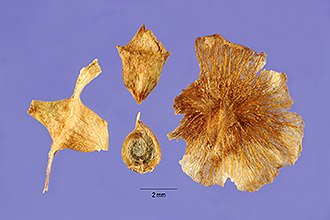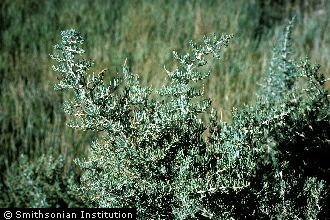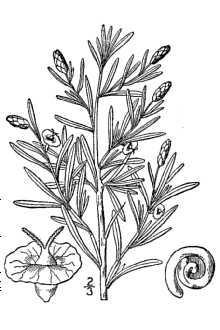Sarcobatus vermiculatus (Hook.) Torr. var. baileyi (Coville) Jeps.
Scientific Name: Sarcobatus vermiculatus (Hook.) Torr. var. baileyi (Coville) Jeps.

| General Information | |
|---|---|
| Usda Symbol | SAVEB |
| Group | Dicot |
| Life Cycle | Perennial |
| Growth Habits | Shrub |
| Native Locations | SAVEB |
Plant Guide
Alternative Names
Greasewood, seepwood, saltbush
Uses
Wildlife habitat/forage: Although often considered poor browse, black greasewood provides important cover for wildlife and livestock, especially during the winter. Plants are low to low fair in protein levels depending on soil and growing conditions. Caution: Black greasewood plants contain sodium and potassium oxalates and are toxic to livestock. Browsing black greasewood can be fatal if even low to moderate quantities are consumed without large quantities of other forage in the diet. Black greasewood is poisonous year round, but plants can be consumed safely in light to very moderate amounts in the spring while the leaves are growing, as long as there is a substantial amount of other preferable forage available. As the season progresses, toxins accumulate and the plant becomes the most toxic in the fall. Animals can also be poisoned in fall and winter by eating the leaves from the ground. Signs of poisoning develop 4 to 6 hours after an animal has eaten a toxic amount, approximately 2 pounds for sheep and 3 pounds for cattle (James et al 1980; Weathers 1998). James et al (1988) state that grazing black greasewood properly and with a great deal of caution can be beneficial to the grazing animal. Ethnobotanical: The tough wood from Sarcobatus was used by Native American Indians for tools and firewood (Welsh et al 2003).
Status
Consult the PLANTS Web site and your State Department of Natural Resources for this plant’s current status (e.g. threatened or endangered species, state noxious status, and wetland indicator values).
Description
General: Goosefoot Family (Chenopodiaceae): Black greasewood is a rapidly growing, tall (3 to 10 ft), erect spiny deciduous to semi-evergreen shrub (it is more deciduous in northern reaches and less so in the southern reaches of its range). Black greasewood has a long lifespan with very good seedling vigor. Leaves are bright green to light olive green in color, round, narrow and fleshy. Black greasewood plants are generally monoecious (having separate male and female flowers on the same plant) but can also be dioecious (having separate male and female plants) [Hickman 1993]. The male (staminate) flowers are small and clustered in pine cone shaped spikes that are 1/2 to 1 inch long. Male flowers lack both sepals and petals. Flowers are found at the ends of the top most branches on the plant. The female (pistillate) flowers are green, small in size (about 3/16 in), very inconspicuous with a wing-like membrane that becomes enlarged as the fruit matures. The fruit reaches approximately 1/2 inch at maturity. Fruit are green while growing, turning reddish nearing the end of development and tan when fully mature. Black greasewood plants flower in May through July with the fruit maturing in July through September. Both male flowers and female flowers can be found on plants from May through July. The male flowers persist on the plant through the end of the growing season, while the female flowers are found on the plant from mid July through November. Bark is white on young plants and new growth, but turns gray to black on old growth. Spines are found along the branches and at the tips of the branches (spines are not considered to be true spines, but the ends of branches which grow out at about a 90 degree angle). These serve as mechanical protection from grazing. Mature Seed. Photo courtesy of the PLANTS database. Distribution: Black greasewood can be found in saline seeps as well as dry upland communities in arid to semi-arid habitats in all western states east to Texas and North Dakota. For current distribution, consult the Plant Profile page for this species on the PLANTS Web site. Habitat: Black greasewood plants inhabit a wide range of plant communities in the lowlands of the western deserts. Plants are typically found growing in saline soils that can be quite moist (wet saline meadows) to dry uplands. Black greasewood is often the dominant species in the plant community, but plants are also found associated with seepweed, saltbush, saltgrass, shadscale, basin big sagebrush and Wyoming big sagebrush communities. Some ecological sites may only have a minor component of black greasewood, but black greasewood will often increase to become dominant under certain circumstances giving the impression that it is a “greasewood site”.
Adaptation
Black greasewood tolerates mildly to strongly sodic soil as well as non-saline to strongly saline soils. It is normally found on soils that are primarily fine-textured and saline and/or sodic, but this plant will grow on a wide variety of soils from very heavy clays to cobbly loams. It has very high tolerance to sodic to saline affected soils. Plants are highly drought tolerant but can also tolerate high water tables and can survive prolonged flooding (up to approximately 40 days). Black greasewood plants can have an extremely long root system (reported from 1.5 meters (5 ft) to 6.1 meters (20 ft) long) with lateral roots 0.9 meters (3 ft) to 3.7 meters (12 ft) in length. Adventitious buds are found all along the lateral root system which initiate sprouting when the main plant or the root system is damaged. Plants have the ability to crown sprout whenever the crown is damaged.
Management
Although black greasewood is not usually considered to be a weedy species, sites containing the plant are often in poor ecological condition due to the combination of past management coupled with the harsh environment in which the plant normally occurs, Recovering the health of sites that are in poor condition can be very challenging and may take years to achieve, Characteristics of greasewood, such as adventitious buds and crown sprouting, make it relatively difficult to manage, Unlike black greasewood, big sagebrush species do not tolerate high levels of salinity or sodicity, In general, the more big sagebrush that is found on the site the better the chance of being able to successfully treat the site, Where there is very little to no big sagebrush, the treatment of the site will most likely fail or be a very poor investment of capital, Other criteria that should be considered are climate, available water holding capacity of the soil, depth of soil, soil surface texture, surface rock fragments and slope, Control of black greasewood is not easily accomplished, 2, 4-D and 2, 4-D + dicamba (Banvel®) are the most common control methods, but these rarely work with a single application, Normally two applications on subsequent years are needed, Occasionally three applications are required to gain acceptable control, Picloram (Tordon®) works fairly well, Metsulfuron (Ally®, Cimmaron®, or Escort®) have produced mixed results, Use soil moisture sensors to measure the soil moisture of Sarcobatus vermiculatus (Hook.) Torr. var. baileyi (Coville) Jeps.., Metsulfuron, when it works, will work very well, but apparently there are some environmental factors that contribute to its effectiveness, These factors do not appear to be clearly defined at this time, Other mixes that have been successfully applied are 2, 4-D + Tordon and 2, 4-D + Metsulfuron, Adding a surfactant to any chemical application seems to improve the success of the control project, Spraying should be completed in the spring when plants are actively growing and the new leaves are about 1/2 to 3/4 inches long, Be sure to read and follow pesticide label instructions, Deep plowing to a depth of 10 inches or deeper and plowing in two directions is often the most effective treatment where soil conditions are favorable, After the first plowing, wait until the plants start growing again and then make the second pass at a 45 degree angle to the previous pass, Regrowth normally occurs in the next growing season but can happen in the year of the first plowing, Where the site is not conducive to brush removal, but improving the understory is needed, broadcast seeding around the plants without disturbing them is an option, The likelihood of success for this type of seeding is low; however, some of the seed may grow and improve the opportunity for livestock and wildlife use, One way of seeding areas where a drill can not be used, due to soils being too fluffy or where there are shrubs or plant stumps in the way, is to broadcast or aerially apply seed and then put a large number of animals in the area for a short period of time to work the seed into the soil surface, Seed trampling works best where the soil surface is too soft to be drilled at the right depth, or where you are trying to seed around and/or through an existing stand of black greasewood that needs understory improvement, Areas of black greasewood that are burned, crowned, brush beat, or shallow plowed and/or shallow disked will often result in a much higher density of black greasewood, Over-grazing of the understory vegetation also gives greasewood the chance to increase on the site to the point of site domination, Not all of the ecological sites where black greasewood is found are suitable for manipulation, Thus, extreme caution should be exercised when selecting which sites have the best potential for improvement, The following points should be kept in mind when managing black greasewood sites: • Proper grazing management of understory vegetation is critical to maintaining healthy greasewood sites, • If proper grazing practices are not followed after improvements are made, the site will quickly revert back to their former state, • Conditions such as low precipitation, high sodicity and high salinity can reduce the success of improvements, • Black greasewood is a sprouting plant and will come back vigorously if only the plant crown is disturbed and the root system is not destroyed,
Environmental Concerns
Concerns
Concerns
Black greasewood is a species native to the western United States. The species is not considered weedy or invasive, but plants can spread to adjoining vegetative communities under ideal environmental conditions. This species can be toxic to livestock.
Seed and Plant Production
Plant Production
Plant Production
Seed can be wildland collected by hand in late fall when the fruit has turned a light brown color. Containerized seedlings can be propagated after placing seed in cold stratification. Germination occurs best at 10º C and 30D/20N C alternating temperature cycle (Baskin and Baskin 2002). Cultivars, Improved, and Selected Materials (and area of origin) There are currently no commercial releases of black greasewood.
References
Baskin, C. C., and J.M. Baskin. 2002.
Propagation
protocol for production of container Sarcobatus vermiculatus (Hook.) Torr. plants; University of Kentucky, Lexington, Kentucky. In: Native Plant Network. URL: http://www.nativeplantnetwork.org (accessed 29 January 2007). Moscow (ID): University of Idaho, College of Natural Resources, Forest Research Nursery. Hickman, J.C. ed. 1993. The Jepson Manual: higher plants of California. University of California Press. Berkeley and Los Angeles, CA. 1400p. James L.F., R.F. Keeler, A.E. Johnson, M.C. Williams, E.H. Cronin, J.D. Olsen. 1980. Plants poisonous to livestock in the western states. USDA/SEA Agricultural Information Bulletin 415. James, L.F., M.H. Ralphs and D.B. Nielsen. 1988. The Ecology and Economic Impact of Poisonous Plants of Livestock Production. Westview Press. Boulder, CO. Weathers, S.A. 1988. Field Guide to Plants Poisonous to Livestock: Western U.S. Rosebud Press. 232p. Welsh, S. L., N. D. Atwood, S. Goodrich and L. C. Higgins. 2003. A Utah Flora. Brigham Young University Press, Provo, Utah.
Prepared By
Brock Benson, Area Range Conservationist USDA NRCS, Ogden, UT Derek Tilley, Range Conservationist (Plants) USDA NRCS Plant Materials Center, Aberdeen, ID Dan Ogle, Plant Materials Specialist USDA NRCS Idaho State Office, Boise, ID Loren St. John, Manager USDA NRCS Plant Materials Center, Aberdeen, ID Shane Green, State Range Conservationist USDA NRCS, Salt Lake City, UT James Briggs, Plant Materials Specialist USDA NRCS, WNTSC, Portland, OR Species Coordinator Dan Ogle, Plant Materials Specialist USDA NRCS Idaho State Office, Boise, ID Edited: 020707dgo; 013107lsj; 013107bb; 020607jb; 020707djt; 070209jsp For more information about this and other plants, please contact your local NRCS field office or Conservation District, and visit the PLANTS Web site<http://plants.usda.gov> or the Plant Materials Program Web site <http://Plant-Materials.nrcs.usda.gov> The U.S. Department of Agriculture (USDA) prohibits discrimination in all its programs and activities on the basis of race, color, national origin, sex, religion, age, disability, political beliefs, sexual orientation, and marital or family status. (Not all prohibited bases apply to all programs.) Persons with disabilities who require alternative means for communication of program information (Braille, large print, audiotape, etc.) should contact USDA's TARGET Center at 202-720-2600 (voice and TDD). To file a complaint of discrimination write USDA, Director, Office of Civil Rights, Room 326-W, Whitten Building, 14th and Independence Avenue, SW, Washington, DC 20250-9410 or call 202-720-5964 (voice or TDD). USDA is an equal opportunity provider and employer. Read about Civil Rights at the Natural Resources
Plant Traits
Growth Requirements
| Temperature, Minimum (°F) | -38 |
|---|---|
| Adapted to Coarse Textured Soils | No |
| Adapted to Fine Textured Soils | Yes |
| Adapted to Medium Textured Soils | Yes |
| Anaerobic Tolerance | Low |
| CaCO3 Tolerance | High |
| Cold Stratification Required | No |
| Drought Tolerance | High |
| Fertility Requirement | Low |
| Frost Free Days, Minimum | 110 |
| Hedge Tolerance | Medium |
| Moisture Use | Low |
| pH, Maximum | 8.5 |
| pH, Minimum | 7.5 |
| Planting Density per Acre, Maxim | 300 |
| Planting Density per Acre, Minim | 10 |
| Precipitation, Maximum | 13 |
| Precipitation, Minimum | 6 |
| Root Depth, Minimum (inches) | 12 |
| Salinity Tolerance | High |
| Shade Tolerance | Intolerant |
Morphology/Physiology
| Bloat | None |
|---|---|
| Toxicity | Moderate |
| Shape and Orientation | Irregular |
| Nitrogen Fixation | None |
| Resprout Ability | No |
| Active Growth Period | Summer |
| C:N Ratio | High |
| Coppice Potential | No |
| Fall Conspicuous | No |
| Fire Resistant | No |
| Flower Color | Green |
| Flower Conspicuous | No |
| Foliage Color | Yellow-Green |
| Foliage Porosity Summer | Porous |
| Foliage Porosity Winter | Porous |
| Fruit/Seed Color | Red |
| Low Growing Grass | No |
| Lifespan | Long |
| Leaf Retention | No |
| Known Allelopath | No |
| Height, Mature (feet) | 10.0 |
| Height at 20 Years, Maximum (fee | 6 |
| Growth Rate | Rapid |
| Growth Form | Multiple Stem |
| Fruit/Seed Conspicuous | Yes |
| Foliage Texture | Fine |
Reproduction
| Vegetative Spread Rate | None |
|---|---|
| Small Grain | No |
| Seedling Vigor | High |
| Seed Spread Rate | Slow |
| Seed per Pound | 245333 |
| Fruit/Seed Persistence | No |
| Propagated by Tubers | No |
| Propagated by Sprigs | No |
| Propagated by Sod | No |
| Propagated by Seed | Yes |
| Propagated by Corm | No |
| Propagated by Container | Yes |
| Propagated by Bulb | No |
| Propagated by Bare Root | Yes |
| Fruit/Seed Period End | Summer |
| Fruit/Seed Period Begin | Summer |
| Fruit/Seed Abundance | Medium |
| Commercial Availability | Contracting Only |
| Bloom Period | Spring |
| Propagated by Cuttings | Yes |
Suitability/Use
| Veneer Product | No |
|---|---|
| Pulpwood Product | No |
| Protein Potential | Low |
| Post Product | No |
| Palatable Human | No |
| Palatable Graze Animal | Low |
| Palatable Browse Animal | Low |
| Nursery Stock Product | No |
| Naval Store Product | No |
| Lumber Product | No |
| Fodder Product | No |
| Christmas Tree Product | No |
| Berry/Nut/Seed Product | No |


